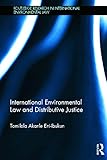International environmental law and distributive justice / Tomilola Akanle Eni-Ibukun.
Material type: TextSeries: Routledge research in international environmental lawPublication details: New York, Routledge, 2014,Description: xii, 136 pages ; 24 cmISBN:
TextSeries: Routledge research in international environmental lawPublication details: New York, Routledge, 2014,Description: xii, 136 pages ; 24 cmISBN: - 9780415659604
- United Nations Framework Convention on Climate Change (1992 May 9). Protocols, etc. (1997 December 11)
- Greenhouse gas mitigation -- Law and legislation -- Developing countries
- Carbon dioxide mitigation -- Law and legislation -- Developing countries
- Climatic changes -- Law and legislation -- Developing countries
- Emissions trading -- Law and legislation -- Developing countries
- Climatic changes -- Government policy -- International cooperation
- Greenhouse gases -- Government policy -- International cooperation
- Global warming -- Government policy -- International cooperation
- Environmental law, International
- LAW / Environmental
- LAW / International
- LAW / General
- 344.04633 AKA.I
| Item type | Current library | Call number | Copy number | Status | Date due | Barcode |
|---|---|---|---|---|---|---|
 Books
Books
|
Symbiosis Law School, Noida Reference | 344.04633 AKA.I (Browse shelf(Opens below)) | 1 | Not For Loan | SLSN-B-7251 |
Includes bibliographical references (pages 123-128) and index.
"The Clean Development Mechanism (CDM) is one of the "flexibility mechanisms" defined in the Kyoto Protocol and is an essential part of the current climate change regime. The CDM has been constantly evolving in order to ensure that it fulfils its objectives of mitigating climate change and contributing to sustainable development in developing countries. The first CDM project was registered in 2004 and there are now about 3,500 registered projects, expected to reduce over 500 million tonnes of carbon dioxide annually and over 2 billion tonnes by the end of 2012. Nevertheless, the CDM is still not perfect, and one of its main problems is the inequitable geographic distribution of projects among developing countries. Although there are currently 123 developing countries that are eligible to participate in the CDM, only 69 countries do so. Of this number, four countries (China, India, Brazil and Mexico) account for about 75% of the projects in the CDM pipeline and most of the 69 host countries host just 1 or 2 projects. Understandably, this is a problem that countries are very keen to address, and since 2001, even before the first project was registered, countries have been highlighting the need to ensure that projects are equitably distributed among participating countries. This book looks at distributive justice under the CDM regime and focuses on the issue of equity in the geographic distribution of CDM projects among developing countries. The book investigates relevant aspects of theory and international law with the aim of identifying the legal characteristics of equitable distribution or distributive justice, in order to establish what equitable distribution in the CDM should look like. The book examines the approaches to equity in international law; the climate change regime; theories of distributive justice; and various international regimes that aim at achieving equity in the distribution of a resource or benefit. Based on these investigations, this book provides a definition of equitable distribution under the CDM and identifies the key barriers to equitable distribution of projects and makes recommendations on how to overcome these barriers. This book will be the authority on distributive justice under the CDM, as there is no other book on this topic and no article that deals thoroughly with the issue. "--
"The Clean Development Mechanism (CDM) defined in the Kyoto Protocol is an essential part of the current climate change regime. The CDM has been constantly evolving in order to ensure that it fulfils its objectives of mitigating climate change and contributing to sustainable development in developing countries. Nevertheless, the CDM is still not perfect, and one of its main problems is the inequitable geographic distribution of projects among developing countries. Understandably, this is a problem that countries are very keen to address, and since 2001, even before the first project was registered, countries have been highlighting the need to ensure that projects are equitably distributed among participating countries. This book looks at distributive justice under the CDM regime and focuses on the issue of equity in the geographic distribution of CDM projects among developing countries. The book investigates relevant aspects of theory and international law with the aim of identifying the legal characteristics of equitable distribution or distributive justice in order to establish what equitable distribution in the CDM should look like. The book examines the approaches to equity in international law; the climate change regime; theories of distributive justice; and various international regimes that aim to achieve equity in the distribution of a resource or benefit. Based on these investigations, Tomilola Akanle breaks new ground in defining equitable distribution under the CDM and by exploring how key obstructions to the equitable distribution of projects may be overcome. The book will be of particular interest to academics and policymakers of climate change and the CDM within international law"--







There are no comments on this title.